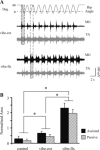Hip proprioceptors preferentially modulate reflexes of the leg in human spinal cord injury
- PMID: 23615544
- PMCID: PMC4073919
- DOI: 10.1152/jn.00261.2012
Hip proprioceptors preferentially modulate reflexes of the leg in human spinal cord injury
Abstract
Stretch-sensitive afferent feedback from hip muscles has been shown to trigger long-lasting, multijoint reflex responses in people with chronic spinal cord injury (SCI). These reflexes could have important implications for control of leg movements during functional activities, such as walking. Because the control of leg movement relies on reflex regulation at all joints of the limb, we sought to determine whether stretch of hip muscles modulates reflex activity at the knee and ankle and, conversely, whether knee and ankle stretch afferents affect hip-triggered reflexes. A custom-built servomotor apparatus was used to stretch the hip muscles in nine chronic SCI subjects by oscillating the legs about the hip joint bilaterally from 10° of extension to 40° flexion. To test whether stretch-related feedback from the knee or ankle would be affected by hip movement, patellar tendon percussions and Achilles tendon vibration were delivered when the hip was either extending or flexing. Surface electromyograms (EMGs) and joint torques were recorded from both legs. Patellar tendon percussions and Achilles tendon vibration both elicited reflex responses local to the knee or ankle, respectively, and did not influence reflex responses observed at the hip. Rather, the movement direction of the hip modulated the reflex responses local to the joint. The patellar tendon reflex amplitude was larger when the perturbation was delivered during hip extension compared with hip flexion. The response to Achilles vibration was modulated by hip movement, with an increased tonic component during hip flexion compared with extension. These results demonstrate that hip-mediated sensory signals modulate activity in distal muscles of the leg and appear to play a unique role in modulation of spastic muscle activity throughout the leg in SCI.
Keywords: reflexes; spasticity; spinal cord injury.
Figures






References
MeSH terms
Grants and funding
LinkOut - more resources
Full Text Sources
Other Literature Sources
Medical

